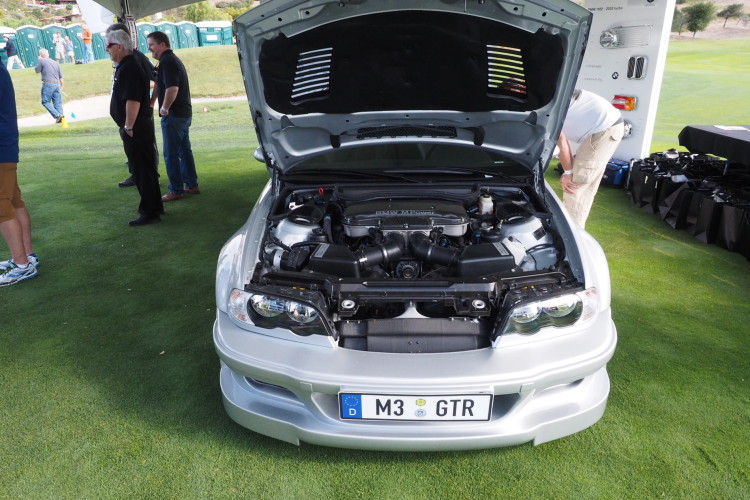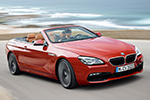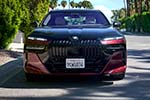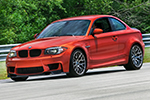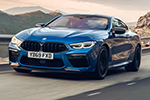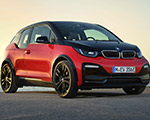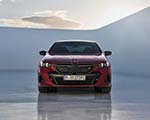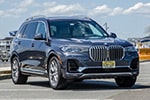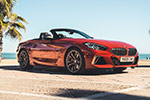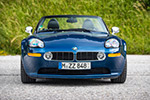Car paparazzi have caught BMW off guard by capturing spy shots of the first-ever electric M3 with its door open. You can tell from the testing rig and plasticky door panel that the “ZA0” is still very much a work in progress. That makes sense, considering series production won’t start until 2027. Don’t judge the interior’s quality just yet. This is a prototype, as evidenced by the fire extinguisher in case something goes awry.
iDrive X Coming To The M3 Also
Look beyond the laptop on the passenger side, the monitor sitting up high, and what appears to be a keyboard, and you’ll notice some production-ready elements. The iDrive X’s central touchscreen dominates the dashboard. This rough interior also features a sporty steering wheel with M-colored stitching. We can also spot a body-hugging passenger seat covered in Alcantara or a similar suede-like material. But again, this is an early prototype and materials or design cues are not indicative of the final product.
But there’s something even more interesting inside. One of the spy shots shows a sticker glued to the base of the B-pillar revealing the VIN. We were under the impression that all M cars use “WBS” and only regular BMWs start with “WBA.” However, that might not be a strict rule for prototypes. It’s worth noting that some early Ms, like the E24 M6 and E28 M5, did have vehicle identification numbers starting with “WBA.”
Very Preliminary Weight Numbers
As for those weight numbers, let’s break them down from top to bottom. Zooming in on the photo reveals 2,675 kilograms (5,897 pounds), allegedly representing the vehicle’s gross weight. This is the maximum weight with people and cargo. Don’t worry about the next figure: 4,475 kg (9,865 lbs) is also allegedly the gross weight plus a trailer. The remaining two numbers represent the maximum weight at the front and rear axles, 1,250 kg (2,755 lbs) and 1,475 kg (3,252 lbs), respectively.
Circling back to the gross weight, the actual car could weigh at least 400 kg (882 lbs) less once you subtract the occupants and their luggage. It could vary quite a bit though and we won’t know for sure until BMW releases them. For reference, an empty Tesla Model 3 Performance weighs 1,851 kg (4,081 lbs). The hot EV has a gross weight of 2,268 kg (5,000 lbs), resulting in a 417-kg (919-lb) difference.
This also pure speculation, but let’s assume the electric M3 ends up around 2,225 kg (4,905 lbs), it’ll be nearly 450 kg (992 lbs) heavier than a gasoline M3 “G80” Competition xDrive. At the same time, it would be about 160 kg (353 lbs) lighter than the larger M5 “G90.” Compared to the i5 M60, the electric M3 would weigh about the same.
However, these are only best guess estimates based on prototype data. The final production M3 “ZA0” could end up lighter. Why? Because the testing equipment mentioned earlier will be removed from the finished model and BMW could include other weight savings measurements. For now, let’s not get stuck on the weight until we see the official numbers.
20 Inch Wheels
Stepping outside the prototype, the electric M3 had 20-inch rear wheels wrapped in Michelin Pilot Sport 5 tires. M logos are visible behind the black wheels, while the camouflage does little to hide the bulging arches. We get the impression it’s smaller than the gas-powered M3, but that might just be an illusion created by the camo.
The test car appears to feature a full-production body, although the taillights are clearly not final. The Neue Klasse design language is noticeable at the front, where the car has cutouts in the camouflage for the parking sensors. While the iX3 and other SUVs will have upright kidney grilles, the sedans will feature a wide grille that merges with the headlights.
There’s still a long way to go before the camouflage comes off. The first step is unveiling the regular i3 (“NA0”) in 2026. Its M sibling will follow about a year later. [Picture credit: Baldauf]
























